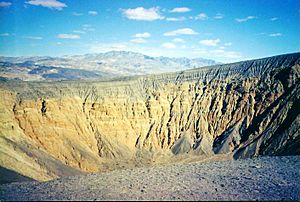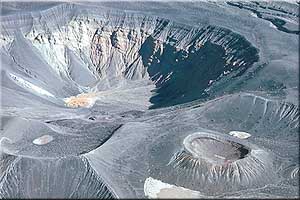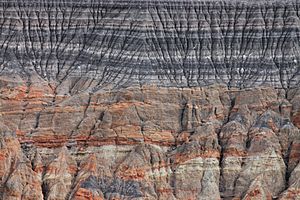Ubehebe Crater facts for kids
Ubehebe Crater is a huge hole in the ground formed by a volcano. It's part of a group of craters called the Ubehebe Craters volcanic field. You can find it in the northern part of Death Valley, which is a famous national park in California, United States.
Contents
Exploring Ubehebe Crater
Ubehebe Crater (say it: YOO-bee-HEE-bee) sits at the very top of the Cottonwood Mountains. This crater is about half a mile (one kilometer) wide. It's also very deep, reaching between 500 and 777 feet (150 to 237 meters) down.
Scientists think the crater is quite old. It might be anywhere from 2,000 to 7,000 years old. However, some newer studies in 2012 suggested it could be as young as 800 years old. But it's still possible it's much older than that!
How Ubehebe Crater Formed
The crater was created by a powerful natural event. Hot, melted rock called magma moved close to the Earth's surface. This magma's heat turned underground water into super-hot steam very quickly. This caused huge explosions! These blasts threw out lots of crushed old rock and new magma across the valley floor.
The magma came up through a crack in the Earth called a fault. This fault also helped lift up the entire Cottonwood Mountains range over a long time.
Volcanic Explosions and Maars
Geologists call these big steam explosions "hydrovolcanic" or phreatic eruptions. The bowl-shaped pits they create are known as maars. Ubehebe was the last and biggest of these explosions in its area. Its eruption was incredibly powerful!
Earlier, smaller eruptions created other shallower maars nearby. One of these, to the south, has a small spatter cone in its middle called Little Hebe. This is the only place in the area where you can see a lot of hardened lava.
Many steam explosions happened at Ubehebe Crater. They sent out ash and rock debris that covered a large area around the crater. This material is light to dark gray and made of tiny pieces of volcanic rock mixed with crushed bedrock. It's thickest right next to Ubehebe, about 80 feet (25 meters) deep.
Before these eruptions, the area had deep ditches and valleys. The volcanic ash and rock buried these features. Over time, wind and water have worn away some of the ash, showing the layers of rock underneath.
One of Ubehebe's explosions created a special type of pyroclastic flow called a "base surge." This happened when a huge column of debris shot into the sky and then began to fall back down. A donut-shaped cloud of hot ash and gas (the base surge) then rushed out from the bottom of the column. It moved very fast, between 100 to 200 miles per hour (160 to 320 km/h), staying close to the ground. This surge covered everything in its path on the side facing Ubehebe.
Layers of Rock and Sediment
The walls of Ubehebe Crater show layers of rock that are millions of years old. These rocks are mostly reddish-orange conglomerate. This type of rock is made of pebbles and stones cemented together. These sediments were laid down by ancient streams. They contain different kinds of rocks like limestone, mudstone, quartzite, and volcanic pebbles up to 8 inches (20 cm) wide.
You might notice that the rock layers in the crater walls have different colors. On one side, they look yellowish, and on the other, they are orange. This color difference is because of a fault (a crack in the Earth's crust) that runs through the crater. Over time, the ground on one side of this fault moved up by at least 400 feet (120 meters), bringing different rock layers next to each other.
Inside Ubehebe Crater, small piles of loose rock and dirt, called talus, have formed on the crater walls. The very bottom of Ubehebe and some other nearby craters are covered in white silt.
Visiting Ubehebe Crater
If you visit Ubehebe Crater, there are three main paths to explore. One trail leads from the parking area right down to the bottom of the crater. Another path goes all the way around the rim (the edge) of the crater. A third trail takes you to Little Hebe, one of the smaller craters nearby.
Be careful when visiting, as the winds at the rim of Ubehebe Crater can be extremely strong. They often blow faster than 50 miles per hour (80 km/h)!






